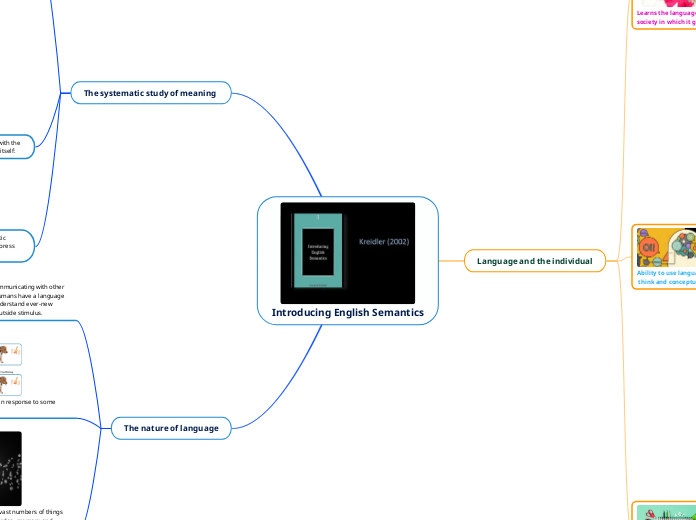BIBLIOGRAPHY:
Kreidler, C. (2002). Introducing english semantics. Routledge.
ESPE. (2023). Semantics and discourse analysis. Obtenido de evirtual: https://evirtual.espe.edu.ec/prg_archivo.cgi?wAccion=ver_archivo&id_archivo=9752628&id_curso=25355&id_unidad=289547
Introducing English Semantics
The nature of language
Humans alone are able to talk about vast numbers of things which come from accumulated knowledge, memory and imagination.
The simple fact is that the human mind deals easily and frequently with what does not exist, or what does not yet exist. Nobody can explain just how people are able to abstract elements from their sensory world and put these elements together in ways that are partly familiar, partly new.
First, animals can communicate only in response to some particular stimulus.
All animals have some system for communicating with other members of their species, but only humans have a language which allows them to produce and understand ever-new messages and to do so without any outside stimulus.
The productivity of language is due to another feature which distinguishes our communication from that of other animals.
The systematic study of meaning
Semantics is the systematic study of meaning and linguistic semantics is the study of how languages organize and express meanings.
Three disciplines are concerned with the
systematic study of "meaning" in itself:
Linguistics
Philosophy
Psychology
Legal scholars argue about the interpretation-that is,
the meaning-of a law or a judicial decision. Literary
scholars quarrel similary over the meaning of some poem or story.
Language and the individual
Parts of grammar
The derivation of different words
which share a basic meaning.
EXAMPLE:
Connect.
Disconnect.
Connection.
The description or the knowledge of word formation.
Syntax.
It is impossible to explore semantics without also dealing with syntax because the two are closely interrelated.
Deals with grammatical categories like tense, number, aspect categories that differ from language to language
knowledge, or the description, of the classes of
words.
Phonology.
Ambiguity
Sequences of words with the same
pronunciation have different interpretations.
Homonyms
Two words sound the same
but have different meanings.
There are units called phonemes which
combine in various possible ways.
knowledge of how speech sounds are
organized in a particular language.
Semantics.
Study of the meaning of words, phrases, and sentences in language.
Mean two things
The explicit description and explanation of it by the linguist.
The implicit knowledge that a speaker has.
Ability to use language,
think and conceptualize.
Know how to combine the vocabulary items into utterances.
Grows rapidly in early childhood.
Contains numerousnames of people and places,
language is creative, our communication
is not restricted to a fixed set of topics.
Subtopic
knowledge is partly conscious and explicit
but to a large extent unconscious and implicit.
Develop at the same time and these
abilities depend on each other.
Learns the language of the
society in which it grows up.
Utterances become more
and more complex.
Interact with others.
Negative statements.
Questions.
By the age of eighteen months
the child producing two-word utterances.
Dolly sit.
Mama shoes.
Daddy byebye.
Approximately at twelve months,
begins to imitate their first words.
Baby.
Doll.
Bed.
Mama.
A child acquires a language in
the first five or six years of life.

